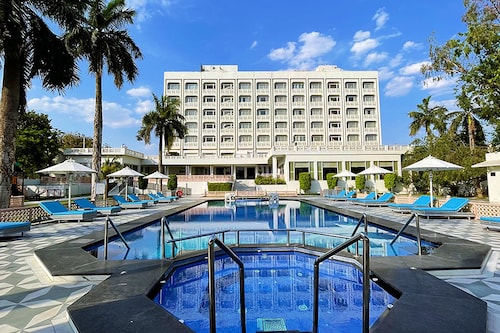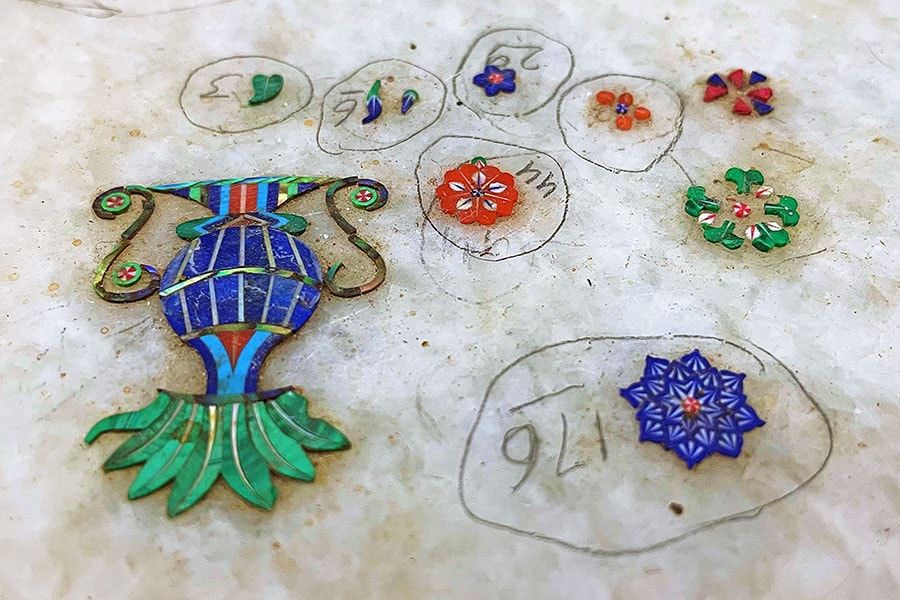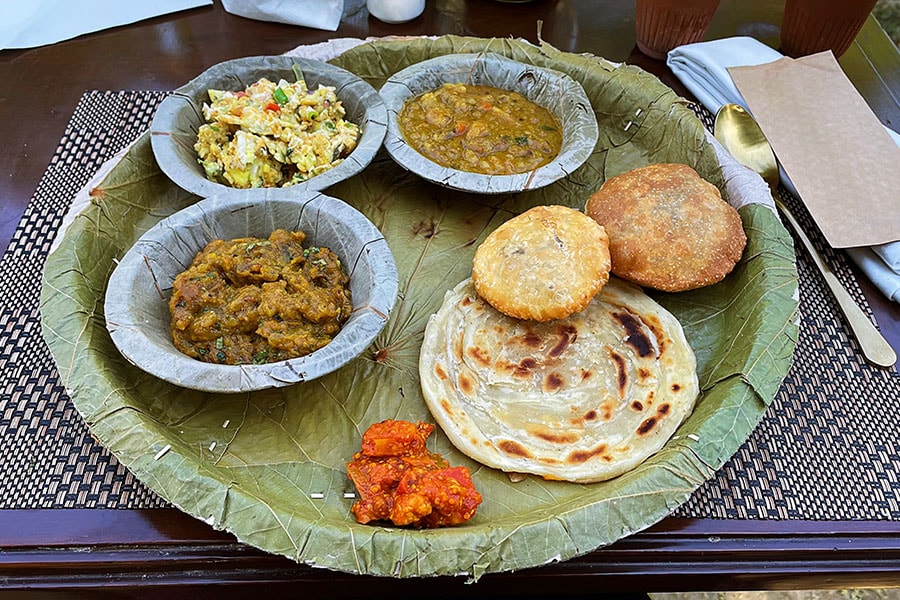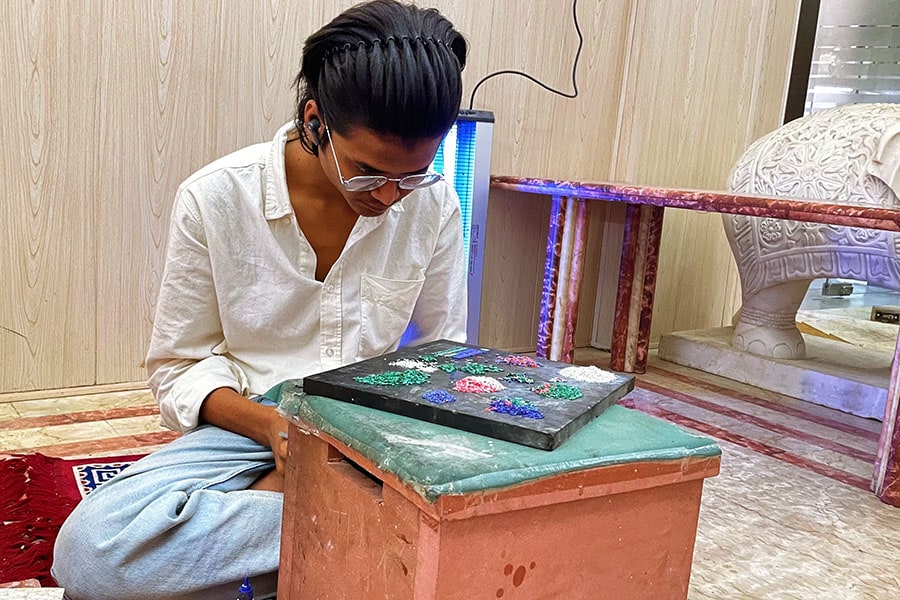Delving into the soul of Agra, through Parchin Kari
In the city of the Taj Mahal, history, hospitality, and master craftsmanship converge, as artisans continue to breathe life into the Mughal tradition of marble inlay work


As dawn breaks at the Tajview Agra, an IHCL Seleqtions hotel, the first slivers of sunlight peek into my suite on the fourth floor. Pulling back the curtains, I"m met with a breathtaking view—the Taj Mahal itself. From this vantage point, the monument built by Shah Jahan, the fifth Mughal emperor, fills my gaze. Inside my suite, every detail pays homage to the iconic monument outside, from the paintings depicting its grandeur, the marble cutlery and bathroom fixtures inscribed with Parchin Kari, to the zig-zag-designed marble flooring mirroring the majestic pillars of the Taj Mahal.
When I reach the Taj Mahal’s eastern gate at 6 am the next morning, kissed by the first light of dawn the Taj Mahal seems to defy time itself, stretching out in a timeless welcome against the canvas of a newly awakened day. My guide, Muzammil Hussain, a certified guide accredited by the Ministry of Tourism of India, tells me: "Emperor Shah Jahan conceived the Taj Mahal not merely as a tomb, but as a paradisical home for his dead wife. He pictured her awakening on the day of resurrection, finding herself amidst this grandeur. Thus, the Taj Mahal epitomises Shah Jahan"s vision of Mumtaz"s celestial abode."
 As the first light of dawn caresses the sky, the Taj Mahal bathes in golden hues, a timeless embrace of sunlight"s kiss. Image: Veidehi Gite
As the first light of dawn caresses the sky, the Taj Mahal bathes in golden hues, a timeless embrace of sunlight"s kiss. Image: Veidehi Gite
He adds, "A significant Islamic passage adorns Darwaza-I-Rauza (royal gate), featuring Surah al-Fajr, the 89th chapter of the Qur"an. In essence, it beckons the virtuous into paradise, exemplifying an eternal dwelling for noble souls. This association is why the gate is often referred to as the gateway to heaven."
He also directs my attention to the Arabic calligraphy adorning the Taj Mahal. “These are sacred couplets from the Quran," he explains, "making the Taj Mahal home to one of the most extensive inscription programs in the Islamic world. There are excerpts from 25 chapters out of 114." The selection of these verses was far from arbitrary, he says. “They were curated to convey a thematic program, a religious iconography of words akin to the figurative decorations seen in churches of that era. While Islam prohibits the depiction of figures or figurines, it allows for the expression of life"s meaning and the afterlife through the Almighty"s commandments. These verses encapsulate precisely that."
 To commence the intricate marble inlay process, artisans first apply a Gerua colour to the marble, creating a striking contrast essential for outlining and inlay work. Image: Veidehi Gite
To commence the intricate marble inlay process, artisans first apply a Gerua colour to the marble, creating a striking contrast essential for outlining and inlay work. Image: Veidehi Gite
But it is as we stroll on that Muzammil shares insights into the monument"s intricate craftsmanship and Parchin Kari, the exquisite marble inlay work that epitomises Agra"s artistic heritage. “Over 20 types of stones were used in the marble inlay work of the Taj Mahal," he informs me. With a deft hand, he illuminates an orange stone with a torch, revealing its luminous quality. “This is cornelian," he says, “which radiates with the touch of light. In the darkness, it glows akin to a fiery ember, like a burning charcoal." Pointing to various stones, he identifies each with expertise. “The black stone is onyx, the green malachite, the yellow jasper, the vibrant blue lapis, and this striking red stone is coral. And observe the dual-toned beauty, that"s abalone, just a glimpse of the many gems here."
The tour of the Taj Mahal culminates with a traditional Agra ka Nashta in a sustainable leaf-stitched plate, back at the hotel. I find myself surrounded by Tajview"s sprawling, six-acre organic garden, where rows of seasonal vegetables flourish—spinach, capsicum, peppers, squash, chillies, gourds, and more. “The authentic "Agra ka Nashta" offers three delightful combinations," Executive Chef Nagendra Singh points out. “One pairs Bedai (also known as Bedmi Puri) with Bhaja, while another features Pyaz ki Kachori alongside khatta meetha (bitter-sweet) Kaddu (pumpkin), and in the non-veg version, the Warqi paratha in Agra is savoured with Akuri, a spicy turmeric-infused scrambled egg dish."
 Available in three delectable combinations, Agra’s traditional breakfast was served on an eco-friendly and biodegradable leaf-stitched plate at Tajview Agra. Image: Veidehi Gite
Available in three delectable combinations, Agra’s traditional breakfast was served on an eco-friendly and biodegradable leaf-stitched plate at Tajview Agra. Image: Veidehi Gite
To conclude the breakfast symphony, I dive into Agra"s famed sweet treats—Ghee Jalebi and Sooji Halwa. These delicacies offer a delightful departure from Petha, Agra"s more widely known dessert. Chef Singh points out, "Agra"s culinary landscape bears influences from both Hindu and Muslim traditions, owing to its proximity to Mathura, Vrindavan, and its historical ties with the Mughal rulers. At Tajview Agra, we celebrate this diversity by presenting both rich Mughlai delicacies and simple Hindu fare."
Following breakfast, my tryst with Parchin Kari continues. A short six-minute drive from the hotel, at Kalakriti, a cultural centre located on the Taj East Gate Road, art expert Vivek Sharma unveils the centuries-old techniques, showcasing how the art form was practised during the Mughal era. Kalakriti plays a vital role in preserving this legacy. They employ nearly 300 families—descendants of the master artisans who meticulously crafted the Taj Mahal"s breathtaking marble inlay.
 Mohammed Zaid meticulously arranges the small pieces of semi-precious stones, preparing them for adhesion onto the intricate design. Image: Veidehi Gite
Mohammed Zaid meticulously arranges the small pieces of semi-precious stones, preparing them for adhesion onto the intricate design. Image: Veidehi Gite
"This art form was introduced to India by Persian artisans during the Mughal era," says Sharma and goes on to introduce me to the family of Mohammed Rafiquddin: Azam, Musheer, and Zaid, the 11th generation of artisans tracing their lineage back to Ustad Ahmad Lahori, the chief Mughal architect responsible for overseeing the construction of the Taj Mahal.
"The tools and techniques employed by these artisans today remain unchanged from those used during the marble inlay work at the Taj Mahal," Sharma adds. The process begins with applying a layer of Geru, a type of clay, onto the polished white marble to create a saffron hue, enhancing the contrast for marble inlay work. Next, around 10 semi-precious stones, identical to those used in the Taj Mahal, are meticulously sliced into small pieces using steel wire. Azam demonstrates the technique, delicately holding the stone between the tips of his fingers, and showcases how it"s skilfully cut into smaller fragments using a wooden cutting tool reminiscent of a charkha (spinning wheel) equipped with steel wires.
Sharma proceeds to display some of the smaller stone pieces, explaining, "While it"s relatively straightforward to hold larger stone pieces between the tips of the ring finger and thumb, for the smallest components of the inlay work, artisans grip them between the tips of their nails." He adds that as they shape the stone with their nail tips, the proximal phalanx of their thumb remains in contact with the stone"s hard surface, which is why they avoid using machines. “The high-speed rotation of machines poses a risk of injury to their fingers. Engaging in handwork, they spend 10-15 minutes slicing the stones, then take a break before resuming. This meticulous process demands intense concentration even the slightest mistake necessitates starting anew."
He elaborates, "The artisans begin by outlining the marble using a chisel, creating cavities approximately 4-5 mm deep in accordance with the design. These cavities are then filled with masala, a proprietary herbal glue recipe passed down through generations. This filling process alone consumes nearly seven hours for each piece. Subsequently, the semi-precious stones are carefully inlaid to match the outline of the design, followed by a drying period lasting another six hours before further inlays can be made." Finally, the pieces are washed to remove the Geru colouration, revealing the finished product ready for sale.
 The art of Parchin Kari (marble inlay work) was introduced to India by Persian artisans, who decorated the walls of the Taj Mahal and various other Mughal monuments with this exquisite craft. A marble plate showcasing the intricate art of Parchin Kari, through a depiction of the Taj Mahal. Image: Veidehi Gite
The art of Parchin Kari (marble inlay work) was introduced to India by Persian artisans, who decorated the walls of the Taj Mahal and various other Mughal monuments with this exquisite craft. A marble plate showcasing the intricate art of Parchin Kari, through a depiction of the Taj Mahal. Image: Veidehi Gite
"Crafting even a small marble piece, such as a coaster, requires approximately 3-4 months. Prices escalate with the intricacy of the design and the size of the marble item," says Sharma.
While this experience offered a glimpse into the artistry and dedication that continues to breathe life into this Mughal tradition, it isn"t the only Seleqtion experience offered by Tajview Hotel to acquaint you with the city. Tajview Agra has introduced 11 new curated experiences since January 2024 that take guests beyond the typical tourist circuit.
“These include Agra ka Naashta, plant your roots, posting stamped postcards, visiting the families who dwell in local art forms such as Parchin Kari, leather craftsmanship and Zardosi, and additional cultural offerings such as our flagship event "Phoolon Ki Holi," says Manpreet Chabba, general manager of Tajview Hotel.
For the Holi, artists from Mathura are invited to perform Rasleela, allowing guests to immerse themselves in the authentic flower Holi celebration, Mathura-style. “Furthermore, we also provide a platform for local artists to showcase their artwork in our hotel," she adds.
 Badshaahi Parosa is a royal banquet uniting the beloved dishes of the Mughal emperors, all on a single plate. Image: Veidehi Gite
Badshaahi Parosa is a royal banquet uniting the beloved dishes of the Mughal emperors, all on a single plate. Image: Veidehi Gite
Needless to say, the Seleqtion experiences encompass culinary delights too. Guests are not just invited to share their favourite recipes with our chefs but also to participate in the kitchen to bring them to life," says Shweta Arora, sales and marketing director. "Yet, one cannot truly experience Agra until they have savoured royal delicacies, such as our Badshaahi and Begum Parosa at Jhankar restaurant," she adds. The Badshaahi Parosa embodies a Mughal banquet (a royal thali) parroting Agra"s culinary legacy. It features favoured dishes of Mughal emperors, including slow-cooked Mughlai mutton stew, panchmel daal, ladyfinger with white sesame seeds, murg tikka mirza hasnoo, ghosht gilafi seekh kebab, ajwain fish tikka, and sultani khushka. A kesariya phirni, infused with saffron and cardamom, concludes the feast. The Begum Parosa offers a vegetarian rendition of this royal thali. The royal essence of this experience is heightened as the food is presented in crockery made from marble and served in clay utensils from Khurja.
The royal experience continues in the Jiva Spa where therapist Thenden, hailing from Nagaland, greets me with a Vishuti chai—a detoxifying blend of lemon, basil, and jaggery. The ‘Orja Dayaka’ massage, a fusion of sesame oil, Ashwagandha, and peppermint leaves me feeling not just revitalised, but renewed. And beyond the spa"s embrace, the presence of Max and Maya, the Labrador mascots, underscores Tajview"s pet-friendly ethos, ensuring every guest feels truly at home.
The royal experience apart, I cannot leave without indulging in Agra’s renowned Petha and Dalmoth. Mohanji, the chauffeur, recommends Gopaldas, an establishment that boasts over four centuries of history. I remember the clusters of Taj Ganj, nestled within the narrow lanes near the Taj Mahal, where several families have upheld the cherished tradition of marble inlay work through generations. “Petha and marble are the soul of Agra," he says. And as I bite into a piece of the Petha, I couldn’t agree more.
First Published: May 03, 2024, 18:07
Subscribe Now